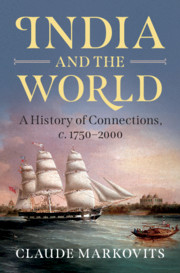Book contents
- India and the World
- India and the World
- Copyright page
- Dedication
- Contents
- Figures
- Tables
- Acknowledgements
- Chronology
- Glossary
- Abbreviations
- Map of India’s Global Connections, 1750–2000
- Introduction
- 1 India in the Global Economy
- 2 India in Global Human Circulations
- 3 India in the World of Wars and Peace
- 4 India in the Global Exchange of Ideas
- 5 India in Global Cultural Circulations
- 6 Indians and Others
- 7 Two Global Indian Events
- Conclusion
- Bibliography
- Index
1 - India in the Global Economy
Published online by Cambridge University Press: 19 March 2021
- India and the World
- India and the World
- Copyright page
- Dedication
- Contents
- Figures
- Tables
- Acknowledgements
- Chronology
- Glossary
- Abbreviations
- Map of India’s Global Connections, 1750–2000
- Introduction
- 1 India in the Global Economy
- 2 India in Global Human Circulations
- 3 India in the World of Wars and Peace
- 4 India in the Global Exchange of Ideas
- 5 India in Global Cultural Circulations
- 6 Indians and Others
- 7 Two Global Indian Events
- Conclusion
- Bibliography
- Index
Summary
Starting with India’s role c.1750 as the ‘workshop of the world’ because of its dominance over global textile production, I chart India’s subsequent transformation into a raw materials producer for Britain and other industrial countries. I take a critical view of the standard Indian nationalist narrative of decline, emphasising the complexity of the process, particularly how important India’s indirect contribution was to the industrial revolution in Britain. I then look at the ‘imperial globalisation’ of the High Imperial Era when India contributed decisively to Britain’s global balance of payments, under the ‘gold standard’. The ‘deglobalisation’ that occurred during the inter-war period opened the way to the post-independence attempt at building a ‘national economy’, which benefited for a while from the Cold War helping to attract investment from East and West to finance costly infrastructures but faced a crisis that led from 1991 to an opening of the economy in the new context of the post-Cold War world. I look at India’s environmental history, too, emphasising its recent entry into the anthropocene era through growing fossil fuel use, and the nature of Indian capitalism.
- Type
- Chapter
- Information
- India and the WorldA History of Connections, c. 1750–2000, pp. 17 - 50Publisher: Cambridge University PressPrint publication year: 2021



